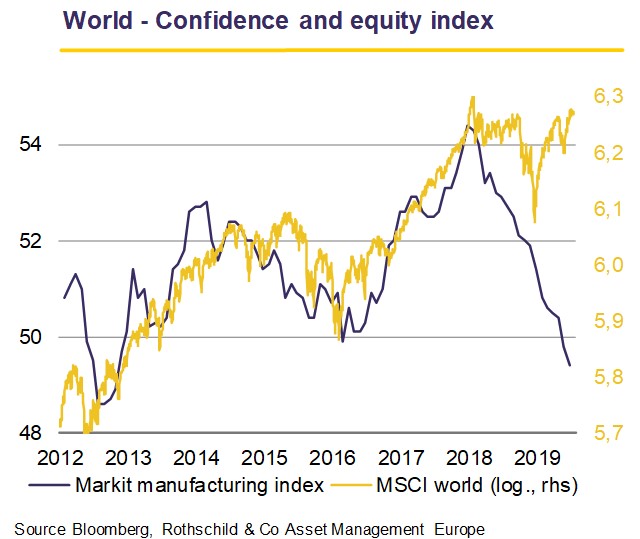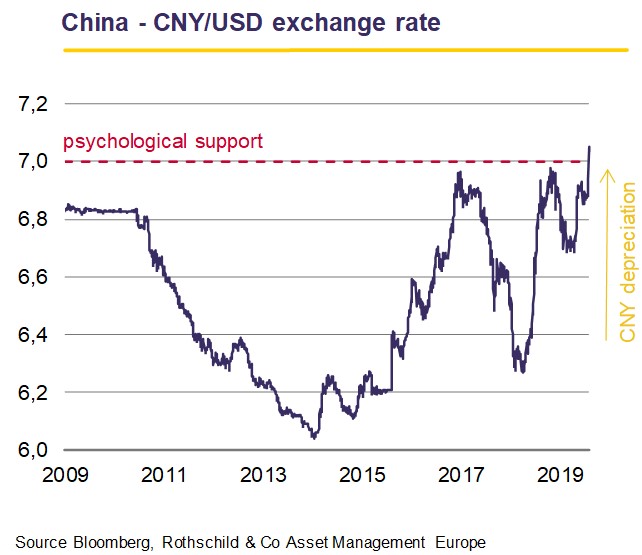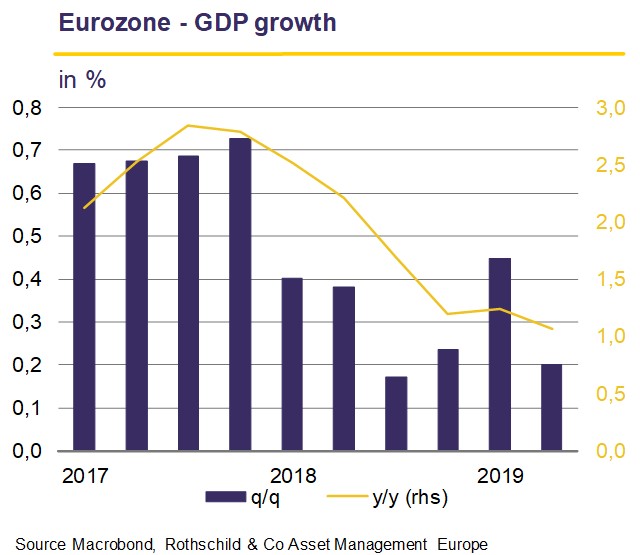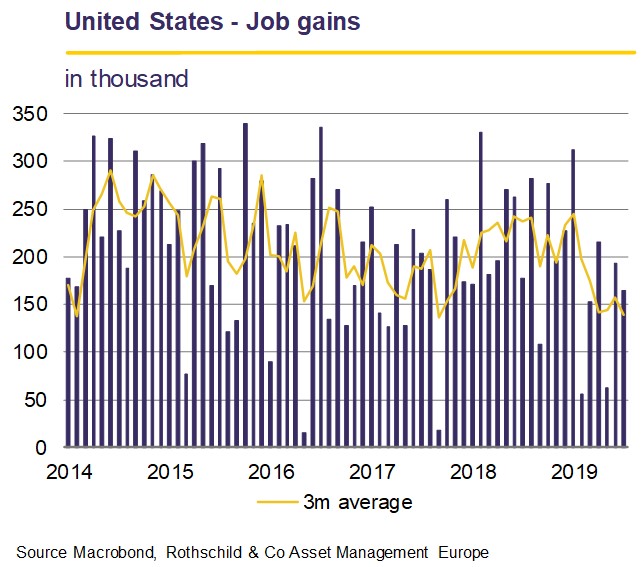Asset Management Europe: Monthly Letter – August 2019

Marc-Antoine Collard, Chief Economist, Head of Economic Research, Asset Management, Europe
Economic environment
The momentum in global activity remained soft in H1 2019, as evidenced by the moves in the bond and the foreign exchange markets where yields fell to historic lows and the USD - a countercyclical currency - remained at its highest level since the early 2000s. At the same time, the divergence with the stock market widened sharply as bad news on the economic front was interpreted by equity investors as good news, as it dissuades the Fed and other central banks from tightening monetary policy, thus prolonging the business cycle.
Click the image to enlarge
This Goldilocks-like scenario is, however, highly uncertain. The recent announcement by US President Trump that his administration would impose a 10% tariff on the remaining USD 300bn imports from China on 1 September abruptly ramped up the trade war between the world's largest economies, further highlighting the geopolitical uncertainty on the path ahead.
In fact, the global economy is operating in uncharted territory, buffeted by a US policy threatening the rules-based system of international trade built since the signing of the General Agreement on Tariffs and Trade (GATT) in 1947, which then became the World Trade Organization (WTO) in 1995.
China responded to the threat of tariff hikes by asking state-owned companies to suspend imports of US agricultural products and letting the yuan to break above 7 for the first time in more than a decade. While a weaker currency would help offset the impact of higher tariffs on Chinese goods, an uncontrolled decline is not without risk. Indeed, the mid-2015 devaluation spurred portfolio outflows which required tighter capital controls and the massive use of foreign currency reserves in order to stabilise global markets.
Click the image to enlarge
The latest depreciation also triggered more reprisals from the Trump administration which has labelled the country a currency manipulator. What's more, China's decision will put most emerging countries' central banks on the defensive, limiting how much monetary easing they can afford, as a rate cut in this environment would add to downward pressure on their currencies.
While predicting and quantifying the overall economic consequences of escalating trade tensions is complicated given the complexity and high level of value chain interlinking, the introduction of tariff barriers increases uncertainty, which indeniably penalises global growth. In that regard, falling business confidence plays a central role in transmitting this shock and most forecasters have been surprised at the depth and breadth of the slide.
The global manufacturing sector remains on a weak footing at the start of Q3 2019 with the Markit index falling to 49.3 in July, its lowest level since October 2012, and signalling a contraction for the third consecutive month. For now, there has only been limited spillover to services and labour markets. However, as the manufacturing and services sectors do not work in isolation, it is unlikely that activity will remain decoupled indefinitely.
Since the stall speed of the world economy is estimated at around 3%, i.e. close to its current pace, the weak activity recorded in recent quarters offers little room for manoeuvre to absorb any exogenous shock. In China, GDP growth moderated amid weak domestic, export demand, reaching 6.2% y/y in Q2 2019 from 6.4% in Q1, the slowest pace since 1992.
Although the credit and fiscal spending impulse has picked up, economic growth has not yet revived. Market participants expect the authorities will make timely use of cuts in banks' reserve requirement ratio (RRR), with two more RRR reductions of 50 bp expected before the end of the year. However, risks to financial stability are far from negligible due to already highly leveraged businesses and the Chinese authorities' room for manoeuvre is most likely limited.
In the eurozone, economic activity halved in Q2 2019 (to 0.2% q/q) and with growth dropping below trend, the ECB risks getting further away from meeting its objectives. Indeed, excluding food and energy, inflation dropped once again below 1% despite unemployment hitting an 11-year low of 7.5% in June.
Click the image to enlarge
Correspondingly, the ECB is expected to set up a policy package at its 12 September meeting, which might include lowering the deposit rate by -10bp (to -0.5%), although a tiered system could be introduced to mitigate possible negative impacts on banks. The Governing Council might also hint of the revival of the asset purchase program. That said, the expected impact of these measures on future economic growth remains an open question.
As widely expected, the Fed cut its interest rate by -25 bp to 2.25%, restating its view that the US economy had solid momentum and characterising the labour market as “strong”. Yet, the rate cut was justified as a precautionary effort to protect the economy from slowing growth in China and Europe and uncertainty over trade tensions and geopolitics, neither of which are likely to dissipate soon.
Click the image to enlarge
In fact, it seems that China and the US are on a collision course with no easy resolution in sight, and that this tension could spill into other areas of policy and create dangerous ripple effects for the world economy. Meanwhile, the probability of a hard Brexit scenario has recently jumped as newly elected UK PM Boris Johnson has vowed to leave the EU by 31 October come what may, even if that means leaving without a deal.
During the press conference, Fed Chair Powell described the decision as a mid-business cycle adjustment to policy - an insurance easing for risk management purposes - as opposed to a lengthy cutting cycle. However, risks to the global economy are decisively tilted towards lower growth than expected, which would force the Fed to cut rates more aggressively than it foresees. Is that really good news?
Download the PDF version Monthly Letter (636 KB)



